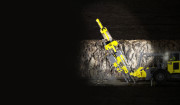When it comes to productivity in underground mining, most of the attention is focused on long hole production drilling. However, to become truly efficient, it is important to review every stage in the production chain.
One example is the technology used for creating vertical opening holes in the orebody before production blasting begins. In stoping methods, the opening hole often connects two levels, while in caving it is drilled as a blind raise from the lower level upwards to the cave.
To succeed with the blasting of the opening hole it is of the utmost importance not to disturb or totally block the next steps in the production.
Different techniques are applied to create the opening holes. Long parallel holes, or slot drilling for blasting of a raise, can be drilled with tophammer drill rigs such as a Simba. The risk of hole deviations limits the length of the raise, especially in fractured rock formations where blasting can also be complicated.
What mine planners prefer
DTH hammers and cluster drills can create larger hole diameters with less deviation, but the compressed air requirement and energy cost are very high. The raiseclimber method produces a large opening and is still used by some mines, but the working environment for the drillers is unfavorable and unacceptable in some countries.
What mine planners really prefer is a long, straight, large diameter opening hole since this will require only a few surrounding blast holes to give the best output, using less explosives as well as minimizing the risk of failure.
A long opening hole without deviation makes it possible for the mine planners to increase the distance between the levels, which provides for huge savings in mine development costs. Also, the time and costs for production drilling and blasting will be reduced when larger volumes of ore can be blasted and excavated in each stope.
The raiseboring technique has the advantage of producing long and large diameter holes with optimum precision and a minimum of deviation. But conventional raiseboring is quite time consuming ? sometimes taking as much as 2 to 3 days, including setup and takedown, and may involve a crew of 3 operators. In addition, conventional raiseboring machines require a concrete base to stand on and have to be fixed with tie-down bolts for stability. They are also heavy and difficult machines to move around.
Considering that many mines produce about 50 opening holes per month, and some as many as 70 per month, this is clearly an area where significant improvements can be made. Several of our mining customers recently challenged us to come up with a better solution which is why we have now introduced a new type of raiseborer ? Easer.
Easer is a highly mobile unit, specially designed for creating opening holes of 750 mm in diameter and up to 60 m long. Moreover, Easer can be used for boxhole boring and downreaming as well as conventional raiseboring. In upwards boxhole boring, the job can commonly be done in one step. A 300 mm tricone pilot bit is mounted about 1 m ahead of the reamer which has three Magnum conical roller cutters. In some cases, the reaming has to be done after completion of the pilot hole, i.e. a two-step operation.
Compared to the drill and blast method, using several smaller holes or a slot of several smaller holes, the large empty hole will only require a few, small, surrounding blastholes (Fig 2 and 3). With a swell factor of 50?60% after blasting, the mine planner can rest assured that the large empty hole will always provide for successful blasting of the opening hole, even when extending the length and the distance between the levels. Furthermore, as Easer is a raiseborer on wheels, there is no special site preparation required and the machine can be easily and quickly moved to different locations.
In developing Easer, our mission was simple: to reduce the time for orebody openings. During tests we found that the total working time for a 40 m long opening hole, from setup to take down, could be considerably reduced compared to conventional raiseboring. Consequently, this concept has the potential to generate significant savings for mines around the world.
The safety factor
From a safety point of view, Easer is also a better alternative. As shown in Fig 2, the tophammer (or DTH) drill and blast method requires several large empty holes to be drilled and surrounded by many smaller holes which then are charged with explosives and blasted. Long-hole drill rigs are highly effective tools for this task ? they can be positioned quickly and offer high penetration ? but since their hole diameters are small and deviation is common, this limits the length of the opening holes. Deviation always affects rock fragmentation and may result in the need to carry out secondary blasting. In the worst scenario the opening hole may have to be abandoned altogether, with the added danger of unexploded charges still remaining in some of the drill holes. With Easer, all of these issues are no longer valid and the mine planner gets peace of mind.
Epiroc operated under the trademark “Atlas Copco” prior to January 1, 2018.




Here:
Us: